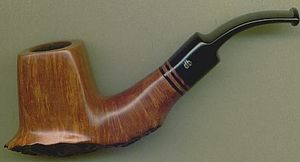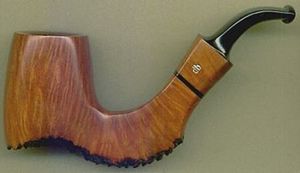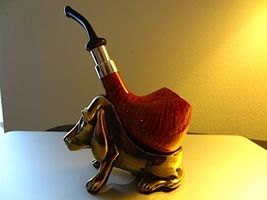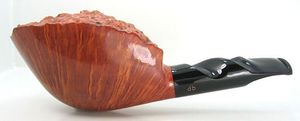Design Berlin
| Design Berlin | |
|---|---|
| Location | Berlin-Kreuzberg & Schweina, Germany |
| Notable Employees | |
After WW II Hubert Hartmann started with pipe repairs to make his living. In early 1948 he founded a company and applied for the permission to start with tobacco pipe production. The later Pfeifenstudio Hartmann was among the first factories in post-war Germany licensed to start pipe production by the Allied Forces. Hubert Hartmann early hired mainly pipemakers coming from the area around Ruhla and Schweina in Thuringia – Germany's most important center of pipe manufacturing since the earliest beginnings. Thuringia was now part of the Soviet zone of occupation (SBZ) which became the later German Democratic Republic (GDR).
Hartmann's mainstay for the next decades were cheap and small pipes in drugstore quality with Nylon stems. Called "Mutzenpfeifen" (also "Mutzchen" or simply "Mutz") in German, they were mainly used to smoke shag tobaccos. This slowly changed for the better after pipe maker and designer Lothar Schirwitz, who had joined Hartmann in 1954, became the head manager of the pipe production at the end of the sixties. Thanks to Schirwitz' efforts Hartmann pipes adopted more modern designs orientated to Danish pipemaking. According to the German smoking habits pipes got the typical 9-millimeter filter system. But doubtlessly the significant approvements on quality enforced by Schirwitz made the pipes a growing success. Around 1975 the brand name db - Design Berlin was adopted to underline the new image.
Lothar Schirwitz also made very fine one of a kind freehands. Today these db pipes wearing his name stamped are highly sought for after he retired having worked almost fifty years for Hartmann / Design Berlin. According to his potential he might have been one of Germany's praised highgraders, but he prefered to stay in the background unboastfully.
In the early 1980s db was taken over by the Dr. Manfred Obermann Company from Berlin and afterwards administrated by Planta Tabak-Manufaktur, one of Germany's biggest tobacco companies (which itself now has been taken over by Mac Baren[1]). The name was changed to Pfeifenstudio db - Design Berlin. Planta's international business contacts helped a lot to increase exports to England and the United States. Switzerland and Austria are also important customers and recently db is selling well in many East European countries.
1993 saw another major step in db's history: Planta / db took over the former VEB Pfeifen und Holzerzeugnisse Bad Liebenstein (shortly Howal for "Holzwaren Liebenstein") that had been closed down in 1990 after the consolidation of the two German states. Howal had been the sole producer of tobacco pipes in the late GDR. The company had been founded by Carl Sebastian Reich in Schweina in 1887 and by it's 50th jubilee in 1937 C.S. Reich was the biggest pipe factory in Germany.
Currently db employs appr. 12 workers in Schweina, where the production of the series pipes was concentrated. The design work and the unique freehands were made for further years in the old workshop in Berlin-Kreuzberg until these activities were also moved to Schweina. Rudolf Apelt, today working on his own as "Baiano", followed Lothar Schirwitz until young and talented Martin Schmalz took over.
Today the annual production is around 30.000 pipes, ranking db as Nr. 2 in pipemaking behind VAUEN. The numerous series lines are complemented by many special models. db is especially eager to create fresh and modern shapes that are considerably popular among the younger pipe smokers.
Some interesting chips:
- At the end of the 1980s db made a business contact with Rainer Barbi. Barbi was contracted to supply pipes under the label „Manufaktur Berlin“. A sales rep from North Rhine-Westphalia had produced the idea. He wanted to have some very special pipes to offer in his sales territory. Barbi delivered exactly 36 pipes to db, which are stamped „Manufaktur Berlin“ and „design r.barbi“ on the underside of the shank.
- Karl Erik Ottendahl, the bustling Danish pipe genius, made some attempts to retire from pipemaking after 2000. Doing so he sold the rights of his registered brand "Karl Erik" (logo KE) in Germany to Design Berlin. And following there were Karl Erik pipes with the typical db twin-bore stem. But Karl Erik Ottendahl didn't get away from pipemaking until his untimely death in 2004 and thus he sold his pipes in Germany under his full name.
Gallery
- Pipes by Lothar Schirwitz
- Design Berlin Gotha #41, courtesy Chip Fadeley
- Design Berlin Gotha #44 and details, courtesy Doug Valitchka
- A Design Berlin example marked Schirwitz, courtesy Doug Valitchka
Contact Information
Pfeifenstudio db - Design Berlin c/o PLANTA Tabak-Manufaktur Dr. Manfred Obermann GmbH & Co. KG Hagelberger Strasse 52 10965 Berlin Germany Website: Pfeifenstudio db - Design Berlin





















